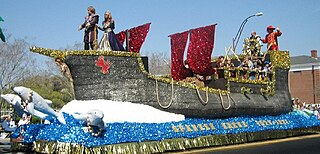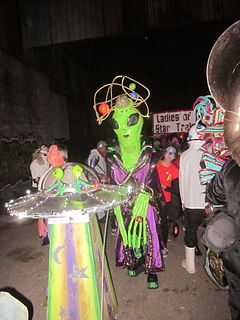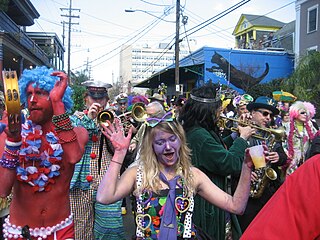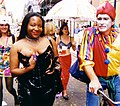
A krewe is a social organization that puts on a parade or ball for the Carnival season. The term is best known for its association with Mardi Gras celebrations in New Orleans, but is also used in other Carnival celebrations around the Gulf of Mexico, such as the Gasparilla Pirate Festival in Tampa, Florida, and Springtime Tallahassee, as well as in La Crosse, Wisconsin, and at the Saint Paul Winter Carnival.
The Mistick Krewe of Comus, founded in 1856, is a New Orleans, Louisiana Carnival krewe. It is the oldest continuous organization of New Orleans Mardi Gras festivities.
Rex is a New Orleans Carnival Krewe which stages one of the city's most celebrated parades on Mardi Gras Day. Rex is Latin for "King", and Rex reigns as "The King of Carnival".

The holiday of Mardi Gras is celebrated in all of Louisiana, including the city of New Orleans. Celebrations are concentrated for about two weeks before and through Shrove Tuesday, the day before Ash Wednesday. Usually there is one major parade each day ; many days have several large parades. The largest and most elaborate parades take place the last five days of the Mardi Gras season. In the final week, many events occur throughout New Orleans and surrounding communities, including parades and balls.
The Krewe of OAK is a small neighborhood New Orleans Mardi Gras krewe and parade held in the Carrollton neighborhood of New Orleans, Louisiana. The parade starts and ends on Oak Street, presumably the origin of the name, although members say that OAK stands for "Outrageous And Kinky".

The Society of Saint Anne is a New Orleans Mardi Gras marching krewe that parades each Mardi Gras Day. The Society was founded in 1969.
The Half-Fast Walking Club is a New Orleans Mardi Gras krewe founded and historically led by Pete Fountain, until his passing on August 6, 2016. Originally all on foot, in recent decades it has also featured one or two small floats. Fountain and other local jazz musicians played through much of the parade. The krewe's current route, basically unchanged since the mid-1970s, starts at 7 AM on Mardi Gras morning, at world-famous Commander's Palace Restaurant on Washington Avenue in the Garden District. The krewe then proceeds downtown on St. Charles Avenue and after a brief interlude on Canal Street, enters the French Quarter at Bourbon Street winds around the Quarter and eventually ends up at the Monteleone Hotel in the early afternoon.
Krewe of Tucks is a New Orleans Mardi Gras krewe.
The Jefferson City Buzzards group is the oldest marching club in New Orleans Mardi Gras, United States. It was started in 1890. The Buzzards have an all-male membership.
KOE, formally known as the Krewe of Elvis, is a Mardi Gras parading organization that consists of members from around the world who meet in New Orleans for Mardi Gras.
The Mystic Krewe of Barkus is a New Orleans Mardi Gras parade where participants are dogs costumed according to a central parade theme. The annual event is organized by the Krewe of Barkus, a nonprofit organization that promotes adoption and rescue of homeless animals in New Orleans. The Mystic Krewe of Barkus makes fun of the more traditional New Orleans Mardi Gras parades and is the only Mardi Gras "krewe" in New Orleans created for dogs.

Mardi Gras is the annual Carnival celebration in Mobile, Alabama. It is the oldest annual Carnival celebration in the United States, started by Frenchman Nicholas Langlois in 1703 when Mobile was the capital of Louisiana. This was fifteen years before New Orleans was founded, although today their celebrations are much more widely known for all the current traditions such as masked balls, parades, floats and throws were first created there. From Mobile being the first capital of French Louisiana (1702), the festival began as a French Catholic tradition. Mardi Gras in Mobile has now evolved into a mainstream multi-week celebration across the spectrum of cultures in Mobile, becoming school holidays for the final Monday and Tuesday, regardless of religious affiliation.

Mardi Gras throws are strings of beads, doubloons, cups, or other trinkets passed out or thrown from the floats in the New Orleans Mardi Gras, the Mobile Mardi Gras and parades all throughout the Gulf Coast of the United States, to spectators lining the streets. The "gaudy plastic jewelry, toys, and other mementos [are] tossed to the crowds from parading floats". "The goodies, or 'throws,' consist of necklaces of plastic beads, coins called doubloons, which are stamped with krewes' logos, parade themes and the year, plus an array of plastic cups and toys such as Frisbees or figurines". The cups that are used as throws are sometimes referred to as New Orleans dinnerware.

A mystic society is a Mardi Gras social organization in Mobile, Alabama, that presents parades and/or balls for the enjoyment of its members, guests, and the public. The New Orleans Krewe is patterned after Mobile's Mystics. The societies have been based in class, economic and racial groups. Mobile's parading mystic societies build colorful Carnival floats and create costumes around each year's themes.

Mardi Gras in the United States is not observed nationally across the country, however a number of cities and regions in the U.S. have notable Carnival celebrations. Most trace their Mardi Gras celebrations to French, Spanish, and other colonial influences on the settlements over their history. The earliest Carnival celebration in North America occurred at a place on the west bank of the Mississippi river about 60 miles downriver from where New Orleans is today; this Mardi Gras on the 3rd of March 1699 and in honor of this holiday, Pierre Le Moyne, Sieur d'Iberville, a 38-year-old French Canadian, named the spot Point du Mardi Gras near Fort Jackson. The earliest organized Carnival celebrations occurred in Mobile, Biloxi, New Orleans, and Pensacola, which have each developed separate traditions. In addition, modern activities generally vary from city to city across the U.S.

The Krewe du Vieux is a New Orleans Mardi Gras krewe more fully known as the Krewe du Vieux Carré.

The Intergalactic Krewe of Chewbacchus is a science fiction–themed Mardi Gras krewe, or parade organization, that also features fantasy and horror groups, among other fandoms. Based in New Orleans, Louisiana, as of the 2019 parade, the Intergalactic Krewe of Chewbacchus has over 2500 dues-paying members who call themselves "ChewbacchanALIENs" or "Chewbs."
Kern Studios is an entertainment production company based in New Orleans, Louisiana, USA. The studio creates large floats for events like Mardi Gras in addition to props and themed environments for theme parks, casinos, and corporate entities.

















